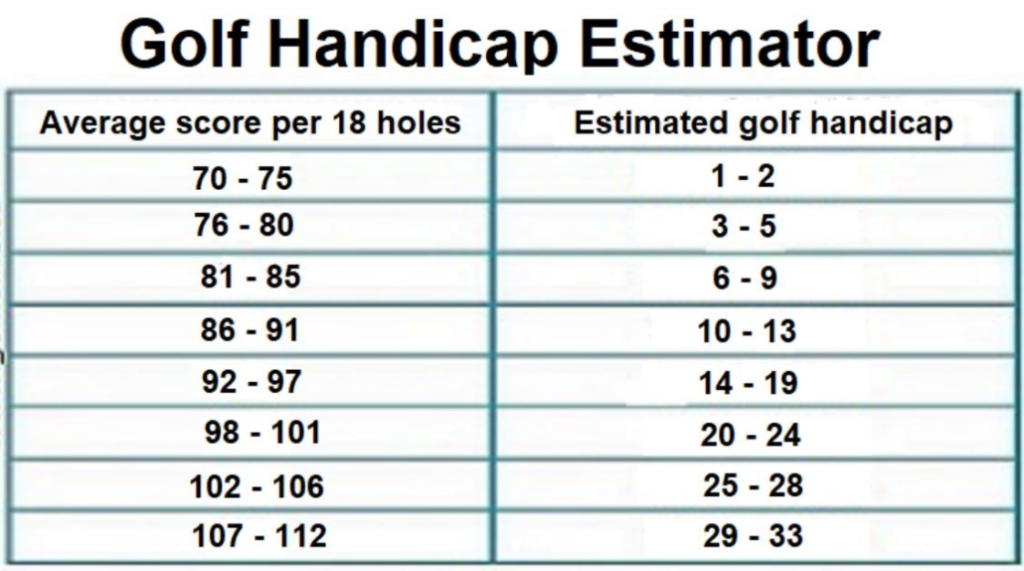Golf handicaps are an integral part of the game for professional players and amateurs. The use of handicaps has been around for centuries. Still, it wasn’t until 2020 that major governing bodies like the United States Golf Association (USGA) and the Royal and Ancient Golf Club of St. Andrews (R&A) agreed on a new World Handicap System (WHS), which is now being used globally.
Golf handicaps work by instituting a numerical system to measure a player’s current golf potential against established golf course ratings. The lower the handicap, the better the player. If a golf course is rated at 72 strokes or par (the score an expert player expects to shoot), a player that shoots 84 would be 12 strokes over par, inferring a handicap of 12.
Golf handicaps are used so that players of different abilities can compete against each other fairly. Handicap totals are usually assigned after a player completes at least three full rounds of golf. When competing with other players, their handicap is deducted from their round score, so a 12 handicapper who shoots 88 on a par 72 course deducts their handicap and is rated for the round at 76.
Handicapping can be confusing, and there are different uses for the term, so let’s get into a little more detail.
Understanding Golf Handicaps

Hundreds of years ago, golfers would compete against each other through agreed-upon methods explained by H.B. Farnie in his 1857 book The Golfers Manual, where he explained: “third-one” (one stroke every three holes), “half-one” (one stroke every two holes), “one more” (a stroke a hole) and “two more” (two strokes a hole).
Whether the players were merely competing or drawing wagers and gambling depends on their experience. Newcomers were reluctant to make such bets since two things were constant in golf through the ages: players embellished their hole successes while overestimating their handicaps. To combat these problems, significant changes came in the late 1800s.
Changes to Handicaps Over Time:
- The late 1600s – simple average score on individual courses
- The early 1800s – strokes given and holes involved, as with third-one, half-one, one-more, two-more
- The late 1800s – using a player’s last three rounds’ scores as their handicap
- 1893 – Ladies Golf Union in Great Britain and Ireland establishes course ratings
- 1911 – USGA begins assigning ratings to US courses using a “par rating” system
- 2003 – USGA includes Equitable Stroke Control (maximum strokes) for handicaps
- 2020 – USGA, EGA, CONGU, Golf Australia, South African, and Argentinian Handicap Systems combine their existing authorities to create the World Handicap System
Historically, golf handicaps were the total of all rounds of golf (9 or 18 holes) divided by the number of rounds. This was improved by giving each golf course a fair rating compared to other courses. The total number of strokes was computed by measuring each hole against what an expert or scratch golfer would score.
Golf Course Rating Factors:
- Fairway length
- Green contours and size
- Distance between hazards and out-of-bounds markers
- Construction and difficulty of exiting bunkers
- Tee box placements
Obtaining accurate and consistent ratings for all golf courses helps improve the World Handicap System. You may experience some changes that affect your handicap.
Critical Changes To The World Handicap System

1. The handicap Index is now an average of a player’s eight best scores from their most recent 20 instead of 10 of 20 with a multiplier of .96.
2. Course rating and Course Handicap are used to compute a player’s handicap instead of just the course rating.
3. Equitable Stroke Control changes to a Net Double Bogey with a maximum hole score for each player of double bogey (2 over par) or Par + 2 + any handicap strokes received.
4. Handicap Index to be revised daily; a benefit of computers and the internet.
5. New safeguards limit extreme upward movement when a score of at least seven strokes or better is posted. Abnormal course conditions or weather are considered, so scores are fairly reflected.
Each of these changes has been implemented to ensure that golf handicaps are accurate for players in all areas of the world. Again, handicaps are used so players can fairly compete against each other.
Are Golf Handicaps Equitable?
The handicap is a reflection of a player’s most recent eight outings, so most often, golf handicaps are equitable in amateur play. That fairness may be stretched when high handicappers play low handicappers because a new or weaker player is likely to make mistakes. The experienced player is not.
Handicaps can also be biased (unfairly) if a player’s most recent scores trend upward as they play poorly, but earlier scores keep their handicap lower.
When Do Handicaps Change?
Handicaps reflect a player’s best eight outings from their previous 20. Any new score below the average of those eight will lower the handicap. Scores above those eight will not increase the handicap until one of the eight falls out of the previous 20 outings.
Are Handicaps Used in Professional Golf?
Although course conditions are used to rate a course (such as par 71 or 72), professionals do not benefit from a handicap system. Their exact score for the day goes on their scorecard and the leaderboard.
In addition, the majority of pro golfers play below par. If we accept par as 72 (for PGA Tour events), of the 196 players listed on PGA scoring, 177 are currently playing under par and wouldn’t get a handicap anyway.
